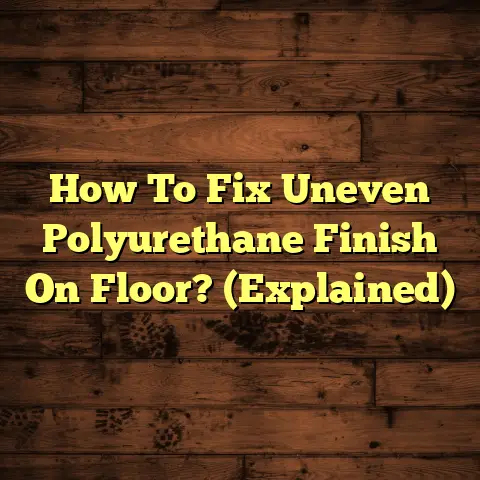What To Put Under Self Adhesive Vinyl Tiles? (Explained)
Have you ever wondered how to achieve that perfect look with self-adhesive vinyl tiles?
I know I have.
Over the years, I’ve installed countless flooring solutions, and self-adhesive vinyl tiles have become a popular choice for many homeowners.
They offer a blend of affordability and aesthetic appeal.
However, choosing what to put under these tiles can make a significant difference in both the installation process and the final outcome.
Why Underlayment Matters
When I first started working with self-adhesive vinyl tiles, I quickly realized that the underlayment plays a pivotal role.
It can affect everything from comfort to the longevity of the flooring.
So, what options do we have for underlayment?
Let’s explore some of the most effective choices based on my experiences.
1. Concrete Subfloor
Using a concrete subfloor is one of the most common options.
It provides a sturdy base that can absorb moisture well.
When I installed tiles over a concrete floor in a client’s basement, I noticed how well the tiles adhered without any issues.
However, it’s crucial to ensure that the concrete is clean and dry before laying down the tiles.
A moisture test can be helpful here.
I recommend using a moisture meter to avoid any surprises later on.
2. Plywood Underlayment
Another option I’ve often used is plywood underlayment.
This is particularly great when you’re working with wooden subfloors that require a smooth finish.
I remember this project I did for a kitchen remodel where the existing floor was uneven.
By laying down a layer of plywood, I provided a perfectly smooth surface for the vinyl tiles.
A ¼-inch thick plywood sheet is generally sufficient for most applications.
However, it’s important to check the specific requirements from the tile manufacturer to ensure compatibility.
3. Foam Underlayment
Foam underlayment is an excellent choice if comfort is a priority.
It adds cushioning underfoot and helps with sound absorption.
During one of my projects in a high-rise apartment, residents complained about noise from the flooring above.
After installing foam underlayment beneath their vinyl tiles, they noticed a significant reduction in sound.
This type of underlayment is easy to install and usually comes in rolls or sheets.
Just make sure you purchase one that’s specifically designed for vinyl flooring.
4. Cement Board
For areas prone to moisture, such as bathrooms or laundry rooms, cement board can be an excellent solution.
While it might be more labor-intensive to install compared to other options, it’s highly effective at preventing mold and moisture damage.
I had a challenging experience during a bathroom renovation where water leakage was an issue.
Using cement board helped me create a durable base that kept the tiles intact despite humidity challenges.
5. Carpet Padding
Believe it or not, carpet padding can also be used under self-adhesive vinyl tiles.
I’ve done this in spaces where people wanted an extra layer of comfort without sacrificing durability.
Just be sure to use a low-density padding that won’t compress too much over time.
Installation Tips
Now that we’ve covered what materials you can use under self-adhesive vinyl tiles, let’s talk about some practical installation tips based on my experiences:
Preparing the Subfloor
Before anything else, preparation is key.
Ensure that whatever subfloor you choose is clean, dry, and level.
I once faced challenges with a project because I didn’t take the time to check the subfloor thoroughly.
The tiles didn’t adhere properly, leading to lifting and bubbling.
Use FloorTally for Accurate Measurements
When working on flooring projects, I rely heavily on FloorTally for accurate cost estimations and material calculations.
It helps me figure out how much underlayment I need without wasting time or resources.
The platform provides local rates for materials and labor, which has been invaluable in planning my budgets accurately.
Follow Manufacturer Guidelines
Each type of vinyl tile may have specific installation requirements depending on the manufacturer.
I always read through these guidelines before starting.
For example, some tiles may require a specific thickness of underlayment while others may not need any at all.
Allow for Expansion
Vinyl tiles can expand and contract based on temperature changes.
When installing, I leave a small gap around the edges to allow for this movement.
This simple step can prevent warping and other issues down the line.
Maintenance Insights
After installation, maintaining your self-adhesive vinyl tiles becomes essential for longevity.
Here are some insights based on my experiences:
- Regular Cleaning: Keep your floors clean by sweeping or vacuuming regularly.
I’ve learned that dirt and grit can scratch the surface over time. - Avoid Excess Moisture: Be cautious with water when cleaning your floors.
Excess moisture can seep into the seams and cause damage. - Use Proper Cleaning Solutions: When it comes to mopping, I use gentle cleaners specifically designed for vinyl floors to avoid damaging the surface.
Challenges and Solutions
Despite all the positive experiences, I’ve faced challenges along the way when using self-adhesive vinyl tiles:
- Adhesion Issues: There were times when tiles didn’t adhere well due to improper surface preparation or high humidity levels.
In those cases, using a primer designed for vinyl flooring helped improve adhesion. - Lifting Corners: I’ve encountered lifting corners after installation due to temperature changes or improper expansion gaps.
To fix this issue, I’ve often re-glued the corners with adhesive designed for vinyl applications.
Comparing Different Underlayment Options
Now that we’ve explored various underlayment options and their installation processes, it’s worth comparing them to see which might be best suited for your specific project needs.
Concrete vs. Plywood
- Concrete: Ideal for moisture-prone areas; provides durability but requires thorough preparation.
- Plywood: Great for uneven wooden subfloors; offers a smooth base but may not provide as much moisture resistance.
Foam vs. Carpet Padding
- Foam Underlayment: Offers sound absorption and comfort; easy to install but may compress over time.
- Carpet Padding: Adds an extra layer of comfort; check density to avoid compression issues.
Cement Board vs. Traditional Underlayment
- Cement Board: Best for high-moisture areas; labor-intensive but provides excellent durability.
- Traditional Underlayment: Easier to install but may not hold up as well in humid environments.
Additional Considerations
When selecting an underlayment, consider factors such as climate, room type (kitchen, bathroom), and your personal preferences regarding comfort and sound insulation.
Climate Considerations
In areas with high humidity, like coastal regions, using moisture-resistant materials becomes critical.
In contrast, in drier climates, standard plywood or foam might suffice.
Room Type
The function of the room also influences your choice of underlayment.
A living room might prioritize comfort and sound absorption, while a bathroom would focus more on moisture resistance.
Personal Anecdotes
Reflecting on my time as a flooring contractor, I recall several memorable projects involving self-adhesive vinyl tiles:
The Kitchen Makeover
In one kitchen remodel, my clients were on a tight budget but wanted an upscale look.
We decided on luxury vinyl tiles with foam underlayment for added comfort since they planned to spend long hours cooking there.
The end result was stunning—an elegant floor that felt great underfoot without breaking the bank.
The Basement Challenge
I had a client who wanted to finish their basement but was worried about moisture issues due to past flooding.
After assessing the situation, we opted for cement board as an underlayment choice paired with moisture-resistant vinyl tiles.
It took more effort upfront, but it provided peace of mind knowing we were safeguarding against potential future problems.
Budgeting Your Project
Cost estimation is crucial when planning any flooring project.
By using FloorTally, I’ve been able to accurately predict costs down to specific materials needed for both underlayment and vinyl tiles themselves, ensuring my clients are aware of their total expenses upfront.
Factors Influencing Cost
- Material Choice: Higher-quality underlayment materials will naturally increase costs.
- Labor: If you’re hiring professionals versus going DIY will impact your overall budget.
- Room Size: Larger spaces require more materials and will thus increase costs.
Common Misconceptions
There are several myths about installing self-adhesive vinyl tiles that I’ve encountered throughout my career:
“You Don’t Need Underlayment”
Many homeowners believe they can skip underlayment altogether with self-adhesive vinyl tiles, thinking they’ll save money.
However, this can lead to issues like discomfort underfoot or inadequate moisture protection.
“All Vinyl Tiles Are the Same”
Not all self-adhesive vinyl tiles are created equal!
Each brand has its own specifications regarding installation methods and underlayment requirements.
Conclusion
Choosing what to put under self-adhesive vinyl tiles might seem simple, but it can significantly impact your flooring project’s outcome.
From concrete and plywood to foam and cement board, each option has its advantages depending on your needs and circumstances.
I encourage you to consider these factors closely based on your specific project requirements.
Preparation is half the battle won!
With careful planning and execution, you can achieve a fantastic flooring solution that lasts for years.
If you have any questions or need advice on your flooring project, feel free to reach out!





